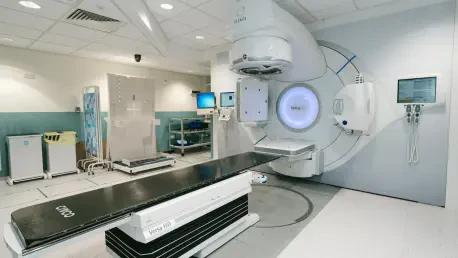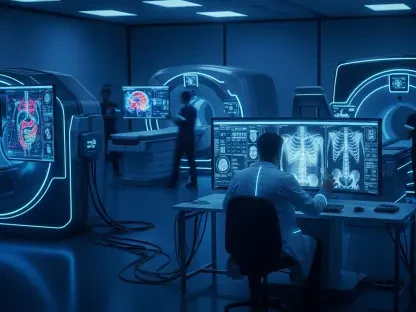Imagine a world where cancer treatment is so precise that every radiation beam targets only the tumor, sparing healthy tissue with pinpoint accuracy, while clinicians manage heavy caseloads with ease, thanks to groundbreaking advancements in radiation oncology technology. This scenario is becoming a reality as innovations redefine cancer care. At the forefront of this transformation is Philips, a global leader in health technology, whose latest innovations are addressing critical challenges in precision, efficiency, and sustainability. Unveiled at the American Society for Radiation Oncology (ASTRO) annual meeting in San Francisco, these tools promise to revolutionize clinical workflows and improve patient outcomes. This review delves into the specifics of Philips’ cutting-edge solutions, evaluating their features, performance, and potential to shape the future of radiation therapy.
Key Features of Philips’ Radiation Oncology Suite
Philips Rembra RT and Areta RT CT Platforms
Philips’ Rembra RT and Areta RT CT systems stand out as next-generation simulators crafted for radiation therapy planning. These platforms prioritize high-quality imaging, delivering clearer visuals that allow clinicians to map out treatments with exceptional detail. With ultra-fast reconstruction speeds of up to 106 images per second, they drastically cut down on scan durations, enabling oncology teams to handle more patients in less time. This speed is particularly vital in busy departments where every minute counts toward maintaining schedules and reducing patient wait times.
Beyond speed, these systems boast advanced 4DCT capabilities, capturing a full respiratory cycle in a single scan that can last up to 500 seconds. This accommodates varying breathing rates, ensuring comprehensive data for dynamic treatment plans that adapt to patient movement. Additionally, an extended 85 cm field of view enhances the ability to visualize larger treatment areas, making these tools indispensable for complex cases requiring meticulous planning.
User experience also takes center stage with features like touchscreen gantry controls, which streamline operations for care teams. A third-party survey validated that 91% of users found these controls improved efficiency, easing the burden on staff. Coupled with high-performance tables for flexible patient positioning and remote collaboration tools for planning and training, these systems address both clinical precision and operational practicality, setting a new standard in radiation therapy preparation.
Helium-Free BlueSeal RT 1.5T MR System
Another groundbreaking addition to Philips’ portfolio is the BlueSeal RT 1.5T MR system, a helium-free solution tailored for radiation oncology. This system leverages AI-powered SmartSpeed Precise software to provide detailed imaging of tumors and surrounding tissues, enhancing confidence in simulation and treatment planning. Such precision is critical for protecting healthy organs while delivering effective radiation doses, a core concern in oncology.
Sustainability marks a significant highlight of BlueSeal RT, operating with just 7 liters of helium permanently enclosed in its cryogenic circuit. This design, combined with a lightweight structure and PowerSave+ efficiency, reduces energy consumption and operational costs while allowing installation in challenging environments like basements. The shift toward eco-friendly medical equipment is evident here, aligning with broader industry demands for greener healthcare solutions.
From a workflow perspective, BlueSeal RT supports MR-only imaging with MRCAT protocols, enabling full simulation in as little as 10 minutes. Shorter scan times not only boost departmental throughput but also improve patient comfort, especially for those enduring procedures with masks. With around 2,000 helium-free MR scanners already installed globally, Philips demonstrates leadership in merging cutting-edge technology with environmental responsibility.
Performance and Real-World Impact
The performance of Philips’ radiation oncology technologies shines through in clinical settings where precision and efficiency are non-negotiable. The Rembra RT and Areta RT CT platforms have shown remarkable results in hospitals, enabling faster treatment planning cycles without compromising accuracy. Their ability to support shared-use radiology further maximizes resource utilization, a crucial advantage amid staffing shortages and budget constraints often faced by oncology departments.
BlueSeal RT, on the other hand, has transformed MR imaging workflows by simplifying processes and reducing reliance on scarce resources like helium. Clinicians have noted significant time savings during simulations, which directly translate to better patient experiences and more streamlined operations. Unique applications, such as remote collaboration tools integrated into these systems, have also facilitated training and planning across teams, ensuring consistency in care delivery regardless of location.
Feedback from industry experts underscores the tangible benefits of these innovations. Christopher M. Freese, MD, from The Christ Hospital, highlighted how Philips’ systems set benchmarks in both precision and operational ease across CT and MR modalities. Such endorsements reflect a growing consensus that these technologies effectively tackle real-world challenges, from complex treatment demands to the need for sustainable, cost-effective solutions in cancer care.
Emerging Trends and Industry Context
Philips’ innovations align closely with emerging trends shaping radiation oncology. The integration of AI, evident in tools like SmartSpeed Precise software and potential partnerships with solutions such as MVision AI’s Contour+ for auto-segmentation, points to a future where technology handles intricate tasks like organ delineation with minimal human input. This trend addresses the pressing need for efficiency as clinical teams grapple with increasing caseloads.
Sustainability is another driving force, with helium-free systems like BlueSeal RT responding to calls for environmentally conscious healthcare equipment. As hospitals seek to lower their carbon footprint and operational costs, Philips’ focus on energy-efficient designs and minimal resource use positions the company as a frontrunner in this shift. This is especially relevant given the global push for greener practices across all sectors, including medicine.
Lastly, the demand for streamlined workflows amid resource limitations is a persistent theme. Philips’ emphasis on user-friendly features, faster scan times, and long-term value—evidenced by initiatives like the “Tube for Life Guarantee” for CT systems—demonstrates a commitment to practical solutions. These trends collectively suggest that radiation oncology is moving toward a more integrated, sustainable, and efficient paradigm, with Philips playing a pivotal role in this evolution.
Challenges in Adoption and Implementation
Despite the promise of Philips’ technologies, certain challenges could hinder widespread adoption. Technical integration, particularly with AI tools like Contour+ software, may pose difficulties for facilities lacking the infrastructure or expertise to implement such systems seamlessly. Ensuring compatibility with existing equipment and workflows remains a hurdle that requires careful navigation.
Regulatory and market barriers also loom large, as the high initial costs of advanced systems like BlueSeal RT or Rembra RT might deter smaller institutions with limited budgets. Training staff to operate these sophisticated tools adds another layer of complexity, potentially slowing down deployment in regions with workforce shortages. Philips’ efforts to mitigate these issues through long-term service designs and cost-saving features are steps in the right direction, but broader accessibility remains a concern.
Moreover, navigating diverse global regulations for medical devices can delay market entry in certain areas. While Philips has a track record of addressing such obstacles, ongoing collaboration with healthcare providers and regulatory bodies will be essential to ensure these innovations reach their full potential. Balancing innovation with affordability and ease of use is a critical challenge that must be addressed for sustained impact.
Looking Ahead to Future Developments
The future trajectory of Philips’ radiation oncology technology appears promising, with potential advancements on the horizon. Deeper integration of AI could further automate treatment planning, reducing human error and enhancing precision in complex cases. From now through the next few years, expect to see Philips exploring more robust algorithms that adapt to individual patient anatomies in real time.
Sustainability initiatives are also likely to expand, with innovations building on the helium-free model of BlueSeal RT. Efforts to minimize energy use and material waste could set new industry benchmarks, encouraging competitors to follow suit. This focus on eco-conscious design will likely resonate with healthcare systems prioritizing environmental responsibility over the coming years.
Partnerships with other tech providers and research institutions may unlock additional capabilities, such as enhanced remote diagnostics or personalized therapy protocols. As clinical complexity grows, Philips’ ability to innovate in response to patient and provider needs will determine its long-term influence. The ongoing evolution of these technologies holds the potential to redefine cancer care delivery on a global scale.
Final Thoughts and Next Steps
Reflecting on the evaluation, Philips’ radiation oncology technologies demonstrated remarkable strengths in precision, efficiency, and sustainability during their showcase at the ASTRO annual meeting. The Rembra RT and Areta RT CT platforms, alongside the BlueSeal RT MR system, proved their capacity to transform clinical workflows and elevate patient care standards. Their real-world impact, backed by expert validation, highlighted a significant leap forward for the field.
Moving forward, stakeholders should prioritize strategies to overcome adoption barriers, such as investing in training programs to equip staff with necessary skills. Collaborative efforts between Philips and healthcare institutions could facilitate pilot programs to test integration in diverse settings, providing valuable data to refine these tools. Additionally, exploring financial models like subsidies or phased payment plans could make these systems accessible to a wider range of facilities.
As the industry progresses, keeping an eye on how Philips adapts to feedback and regulatory landscapes will be crucial. Engaging with oncology communities to address specific regional needs can further tailor these innovations for maximum benefit. Ultimately, the path ahead involves a collective push to ensure that cutting-edge technology not only advances cancer treatment but also reaches every patient who stands to gain from it.









